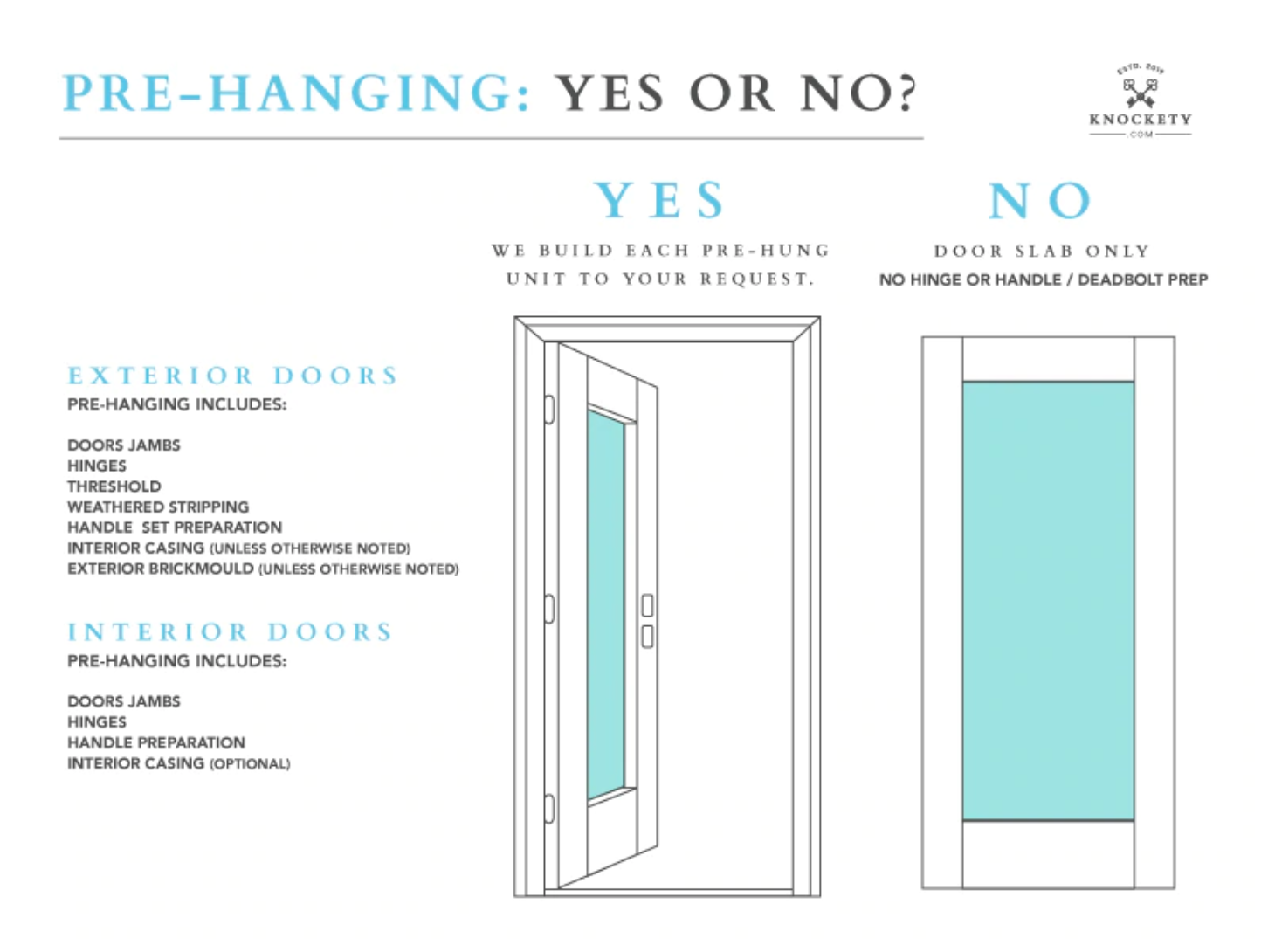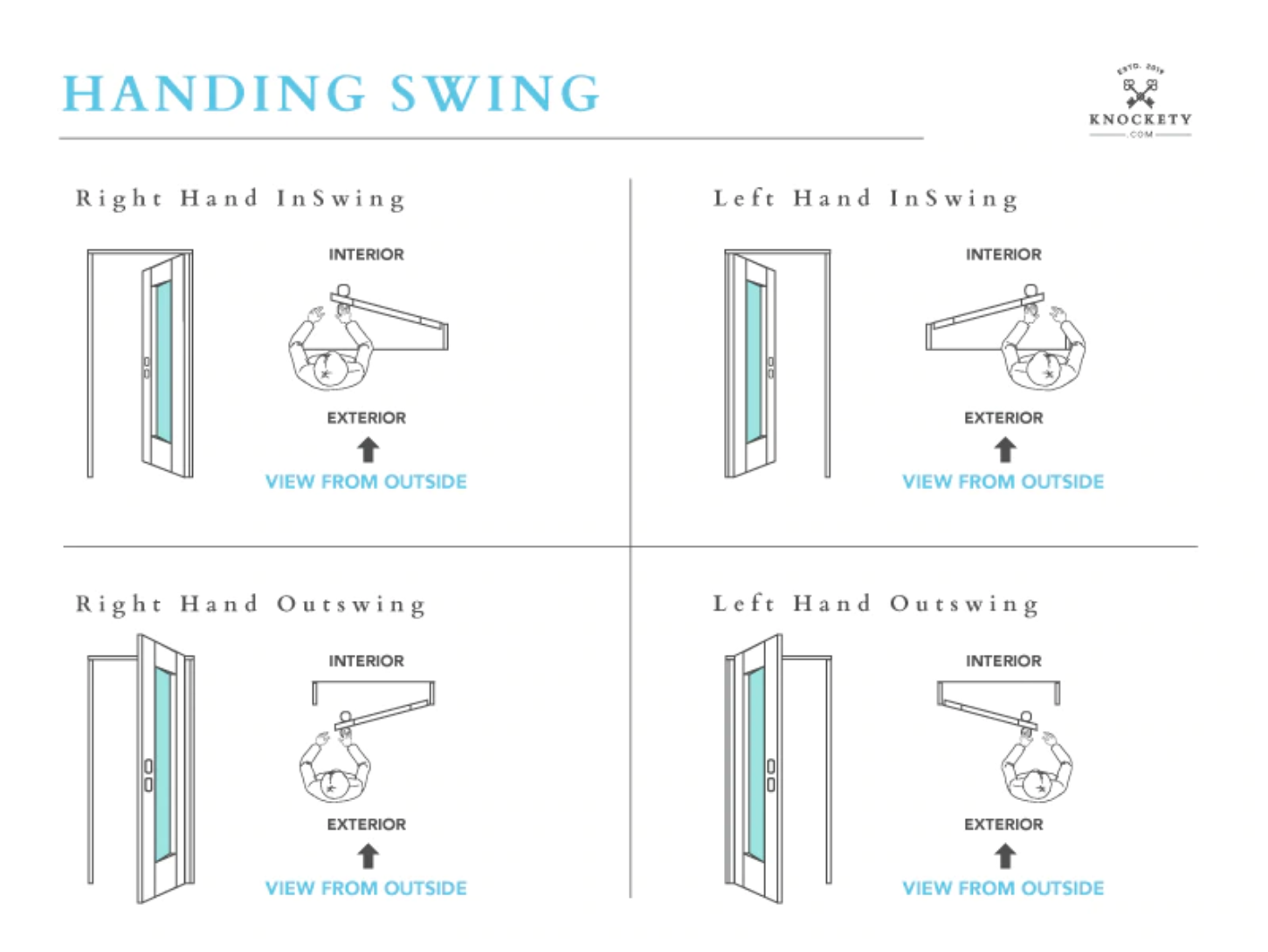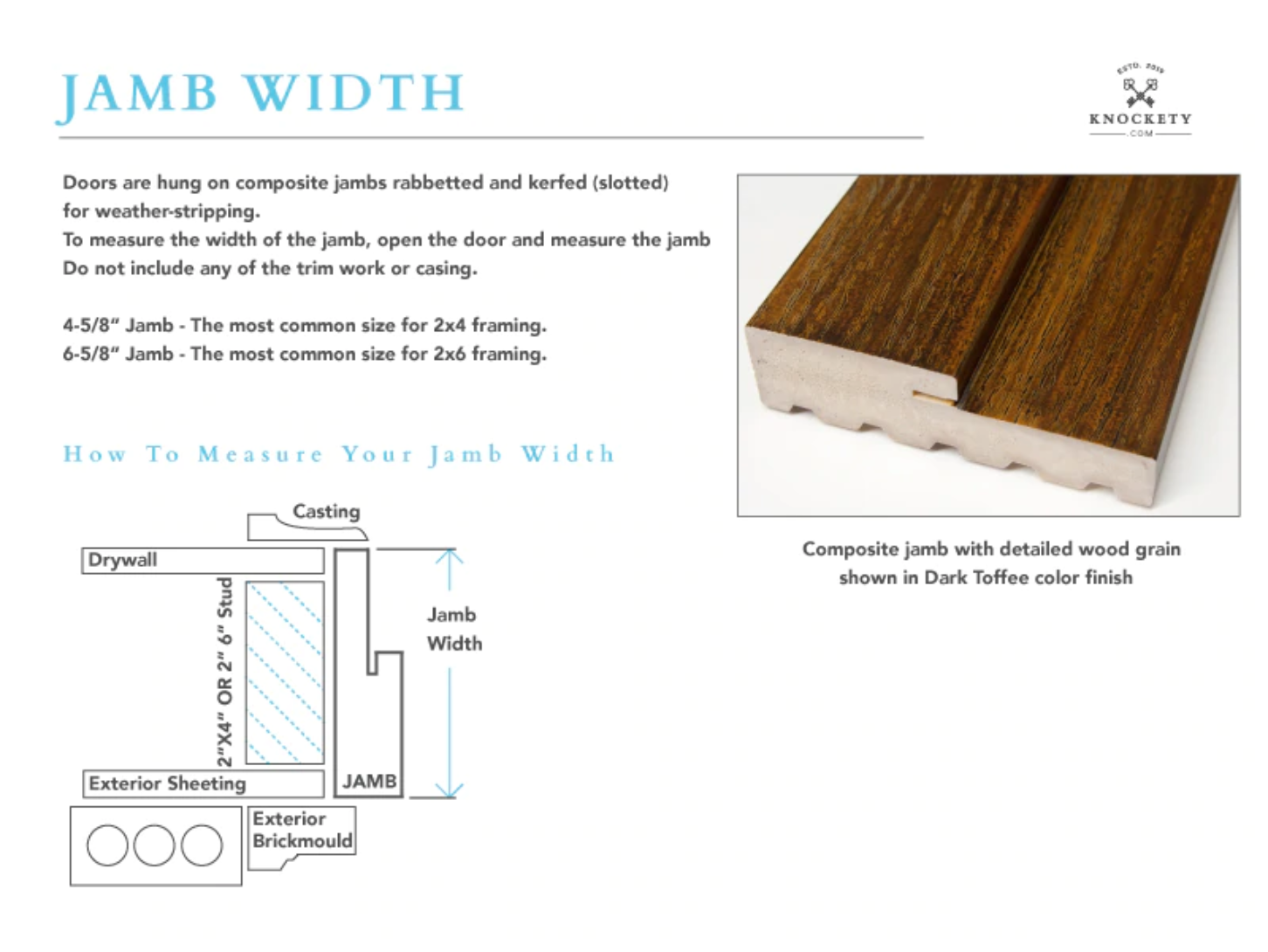Buyers guides
Purchasing a new door involves far more than just choosing a style you like. From size to materials and security, you have many options to consider. But don’t be overwhelmed! Use our handy door buying guide to get an overview of the best styles for your home.
Factors To Consider
-
Why Do You Need A New Door?
Any part of your home will need repairs or replacement at some point. Doors are no exception. An older house may have an equally old door with faded paint or a deadbolt that doesn’t quite work anymore. Maybe your current door is badly damaged and in desperate need of replacement. Maybe constant drafts are allowing your climate-controlled air to escape, raising your energy bills. Maybe you’re trying to sell your home and need to increase it’s curb appeal. Maybe you just want something new. But whatever your reason, we’ve got the model you’re looking for!
-
Wood Vs. Fiberglass Doors
Wood and fiberglass are two common and affordable choices for door materials. But like any home renovation, they both have their pros and cons. Let’s take a closer look at each kind of door.
Wood Doors
Wooden doors give your home a more traditional, natural appearance. With a wide range of prices depending on the quality and finish of the wood, a well-built wooden door won’t break your budget. Best of all, if you live in an area prone to heavy rain, don’t worry. The sturdy construction of the door frame and panels protects your door against significant weather damage.
Wooden doors perform best in shaded or somewhat protected areas, such as inside a nestled entryway. This significantly delays fading and keeps your door at peak condition for far longer. However, the wood will require periodic resealing to maintain its color and prevent extensive water damage.
Fiberglass Doors
If you love the look of wood but would prefer a lower maintenance material, fiberglass is an excellent choice. Fiberglass can easily be customized to mimic the wood grain of a more conventional door to preserve the appearance you want without the need for resealing. Better yet, fiberglass doors are designed to stand up to severe weather while keeping your home energy-efficient. This material is a favorite of many homeowners.
-
Local Building Codes
The last thing you want is to find the perfect door, only to discover that local regulations won’t allow it. Most building codes addressing residential doors are relatively straightforward. But some regions may have stricter requirements. For instance, a hurricane-prone region may require storm doors, a rule that somewhat limits your choices. A neighborhood HOA may also place limits on using certain colors to paint or stain your door. Look up your region’s building codes or talk to one of our team members for more information.
In regions prone to extreme weather, local regulations may also require your door to be energy efficient. Doors and windows must meet certain standards to keep your home at a reasonable temperature all year round. New doors are designed with these standards in mind. But for added energy efficiency, you can’t go wrong with an Energy Star- certified door. To earn this certification, a door has to meet particularly strict standards and pass several tests to show that it can prevent your home’s climate-controlled air from escaping. Any door with the Energy Star seal of approval is a truly efficient door in any climate!
-
Sliding Vs. Hinged Doors
The location and function of a door will help determine if it should be hinged or not. For instance, very rarely is a sliding door used as the main entryway to a home. Privacy concerns and typical home construction don’t allow it. Front entryways are virtually always hinged doors, with the hinges on the inside for security reasons.
It’s far more common to see sliding doors on the back patio or inside the home. Sliding doors save space, which can be quite helpful in a small house. They also generally come with large glass panels to let in natural light or provide an informal division between interior rooms. Which style works best for the door you need?
Slab Vs. Prehung Doors
A slab door is simply a cut and prepared door with no hinges, knobs, frame, or other necessary parts attached. This simple approach works best if only the door itself needs replacing rather than the frame. However, you will have to provide the required hardware.
A prehung door (or door system, as it’s sometimes called) is ready to install immediately. A prehung door comes already attached to a frame, with the knobs and hinges in place. All that’s left to do is install it. This approach works best for more extensive home renovations.

Interior Doors
Sizing
Interior doors generally measure 1.75 inches thick. Depending on the width of the frame, the door could measure 24 inches, 28 inches, 30 inches, 32 inches, or 36 inches across. Each interior door must measure at last 80 inches tall.
Make sure your new door will fit! If you’re buying a pre-hung door, measure the distance between the studs with no door installed. For a slab door, measure the existing frame and keep the dimensions handy.
Finish
Both wooden and fiberglass doors need finishing to add color and provide a weatherproof seal. Whether you prefer a certain color or would rather do the finishing yourself, you have plenty of choices! Your finishing options include:
- Unfinished: This type of door is sanded and ready to install, but unpainted and unstained. You will have to treat it yourself, but this does give you slightly more control over the door’s final appearance.
- Primed: This door comes sanded and sealed, but unpainted. Half the finishing work is already done for you.
- Stained: This model comes pre-treated and stained to draw out the natural color of a wooden door. The finish can range from a lighter honey-like wood color to dark, rich shades. Fiberglass generally can’t be stained.
- Prefinished: This door is sanded, stained and/or painted, and prepped with holes for the hinges and knobs. All you have to do is install the hardware and hang it up!
Styles
Interior doors don’t have to be solid panels! Some homeowners brighten up a room with a divided lite door, a model fitted with a glass panel to give the occupants a window to the rest of the house. Others opt for a sliding door to save space in a small kitchen or discreetly hide a utility closet. It all depends on your home’s existing style.
CHOOSING A COLOR FOR YOUR FRONT DOOR
Your front door is the first impression people have of your home before they enter, so picking a style is important, but what about the color? Of course, you can go with basic black or white or a wood tone, but what if you want something that better reflects your home’s interior? Before you get started, if you have an HOA then it’s a good idea to make sure there aren’t rules that limit what colors your exterior door can be.
Typically, you will want your front door to coordinate with the exterior of your home, but that doesn’t necessarily mean you need to exactly match the other trim on your house, although that is always an option. But if you want to branch out to other colors, try using a color wheel to find colors that go well with the main colors on your home. You can search online for color wheels or click here to use the Canva color wheel tool. Find a complementary color that will go well with the rest of your home by picking colors that are adjacent to the colors on your home, or you can go with colors across the wheel for a more exciting pop of color. Ultimately, choose a color that you like and will be happy with.
At knockety we have a wide variety of finishes to choose from with each of our doors. You can purchase finish samples before choosing a door color, and you can even buy our doors unfinished and paint them whatever color you choose.
Knobs
A door’s hardware can be both functional and decorative. For private rooms, like a bedroom or restroom, locking knobs are essential. Sliding doors or similar styles without latches don’t need knobs, but a dummy knob or handle helps the door match the rest of your home.
A doorknob can even contribute to the room’s decor. For instance, a knob with an eye-catching finish contrasts with the door itself for a bold appearance. Alternatively, intricately designed door handles add a subtler touch of elegance. Your doorknob choice reflects your personal style as much as the door itself.
Door Swing
Door swing, sometimes called handing, refers to the placement of the hinges and which way the door swings when it opens. You can determine the type of door you have by standing outside the room where it leads. For instance, stand in your hall facing the bathroom door. Take note of where the hinges are. A left-handed door has the hinges on the left side, while a right-handed door has its hinges on the right.
Doors swing toward their hinges. As a result, a left-handed front door with hinges on the inside will swing into the house when opened. This isn’t always a good choice for interior doors, however. You don’t want the bathroom door to swing inward and hit the sink! Consider your home’s floor plan and where to position the hinges to save space.

Exterior Doors
Sizing
A standard front door is 80 inches tall, 1.75 inches thick, and 36 inches wide. Alternative styles can be as narrow as 24 inches wide or as tall as 8 ft. French doors can double the width since the entrance consists of two door panels side by side. Exact dimensions will vary slightly, so make sure to have accurate measurements on hand during your search for a new door.
Jamb Width
Jamb width is the width of the wall that you are installing the door into. This includes everything from the sheetrock to siding on the outside of the wall.

Styles
Whatever your home’s aesthetic, exterior doors can offer a matching style! French doors, or simply divided lite doors, give your home an extra window. Sliding glass doors give the entrance to your backyard an especially open feeling. Traditional doors add a sturdy, elegant look to virtually any home design. Your only restriction is the size and shape of your doorway.
Durability
How durable does an exterior door need to be? That depends on its location. A front door is likely to be uncovered and thus endures more exposure to potentially damaging weather, while a back door might be covered by a patio. Both wood and fiberglass will work for either type of door. However, an uncovered wooden door regularly exposed to heavy rain may suffer damage with time. Fiberglass offers a more durable alternative. Wooden doors work best in a partially covered area to extend their lifespan.
Sun exposure is also important to consider. Doors facing west or south are exposed to the most sunlight, placing them at higher risk of fading or trapping heat. In a warm climate, this can be unpleasant. Make sure these doors are covered by a particularly large overhang if possible. Otherwise, opting for a lighter color will reflect some of the heat away from your house.
Finish
A basic door on its own gets the job done. But why stop there? Try pairing your new door with additional accessories or customizing the door itself. A few particularly worthwhile examples include:
- A knocker that matches the door knob
- A peephole to see who’s waiting outside
- A door chain to let you look outside without fully opening the door
- Sidelites to let in more natural light around the door
- Patterned or stained decorative glass in a divided lite door
- A transom, a decorative “crown” of windows that top off the doorframe
- A doorbell for the front entrance
- A special window with blinds mounted inside for added privacy
- An adjustable threshold or sweep to seal the bottom of the door
Your front entry door is one of the first things people notice from the street. Meanwhile, the back door leads to a private area where your family will spend a lot of time. Make sure both make your house look amazing!
Security
Finally, security is an important part of any exterior door. Both the front door and the back door will require locking knobs or deadbolts. For a quick, less expensive option, locking knobs will do. However, most homeowners opt for deadbolts for added security. You can choose between standard deadbolts, locks with a keypad that require a code, and even advanced models that unlock with a command from your smartphone. Whatever your choice, a reliable lock on an exterior door is an absolute must.
But deadbolts aren’t the only security element. On exterior doors, hinges should be mounted on the inside to allow the door to open inward. This design choice serves several purposes. First, it allows you to open the door just a crack to see outside if necessary. Second, this design allows you to more easily close the door on someone to keep them from forcing their way inside. And finally, keeping the hinges inside prevents burglars from tampering with them to break in. You shouldn’t have to worry about the hinge placement since exterior doors are designed with these principles in mind.
Assembly Instructions
Upgrade Your Door Today!
Ready for a change? Whether your existing door is falling apart or you’re just bored with it, we have the perfect replacement! Our team strives to create the best doors for your home. After you choose the type of door you want then check out our large selection of doors. Then place your order, select a shipping option, and wait for your beautiful door to arrive.
ready for a new entry door?
Find it in our inventory and get in touch with our sales team to get started today.